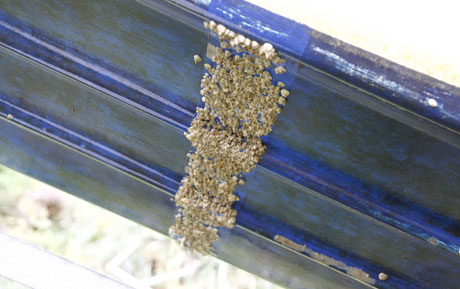Oct 5 2011
It is not necessary for an effective anti-fouling coating to release toxins into the environment. Scientists at the University of Gothenburg have shown that it is instead possible to mix into the coating molecules on which the adult barnacles cannot grow. The result has been published in the scientific journal Biofouling.
Fouling of hulls is a problem for all boat owners, and one of the most difficult organisms to deal with is barnacles. A research group at the Department of Cell and Molecular Biology has therefore studied the biology of barnacles in detail, and focussed on one particularly sensitive stage in the barnacle life cycle.
 Part of the hull of a planing boat that has been painted with a copper-free TF paint with trace amounts of a macrocyclic lactone (Ivermectin). The broad stripe in the centre was painted with TF paint without additive. The boat was used in traffic on the western coast of Sweden for four months in the summer of 2009. Boat owner: Mauritz Palm. Photo: Mats Hulander
Part of the hull of a planing boat that has been painted with a copper-free TF paint with trace amounts of a macrocyclic lactone (Ivermectin). The broad stripe in the centre was painted with TF paint without additive. The boat was used in traffic on the western coast of Sweden for four months in the summer of 2009. Boat owner: Mauritz Palm. Photo: Mats Hulander
"When newly matured adult barnacles attempt to penetrate through the coating in order to establish a fixed location to grow, they are extremely sensitive to certain molecules known as 'macrocyclic lactones', which are normally produced by certain bacteria", says Professor Hans-Björne Elwing of the Department of Cell and Molecular Biology at the University of Gothenburg.
A better effect with no toxin released to the environment
When such molecules are mixed into the anti-fouling coating, the treated surface is first colonised by barnacles in the normal way. But as soon as the young barnacles have matured into adults and attempt to establish stronger contact with the surface, they lose contact and probably die. It is also the case that certain brown algae counteract the colonisation by barnacles on the surfaces of leaves in a similar manner.
"Using this discovery, we have managed to create coatings with new binding agents that shut down the release of the macrocyclic lactones into the marine environment. Further, only trace amounts of the macrocyclic lactones are required in the coating to give full effect against barnacles."
The research group has shown through field trials on leisure craft that the addition of macrocyclic lactones can fully replace copper in coatings used on such craft, on both the eastern and the western coasts of Sweden, and for several seasons.
"While it is true that it is only barnacles that are affected by the additive, the growth of algae and similar organisms can be counteracted relatively simply by other methods."
The study has been carried out by Emiliano Pinori, Mattias Berglin, Mats Hulander, Mia Dahlström and Hans Elwing at the University of Gothenburg, in collaboration with Lena Brive at the SP Technical Research Institute of Sweden in Borås. The article Multi-seasonal barnacle (Balanus improvisus) protection achieved by trace amounts of a macrocyclic lactone (ivermectin) included in rosin-based coatings has been published in the journal Biofouling.